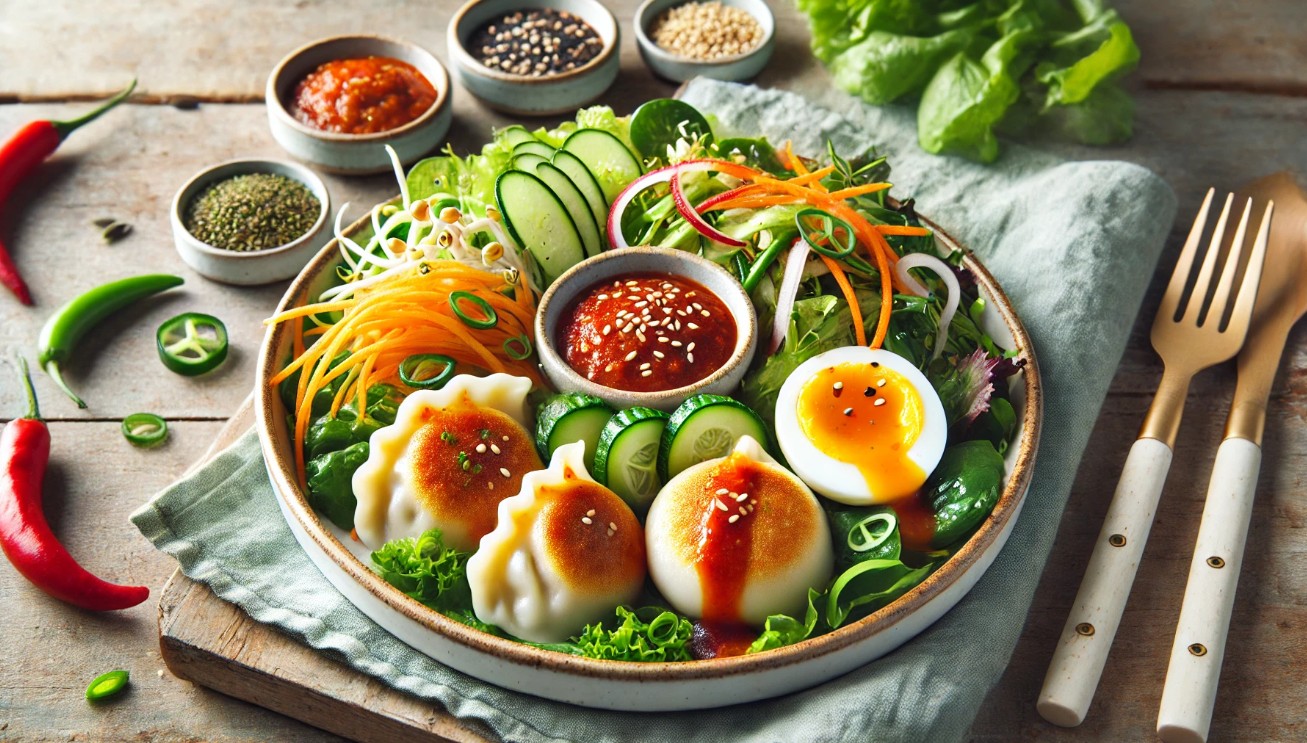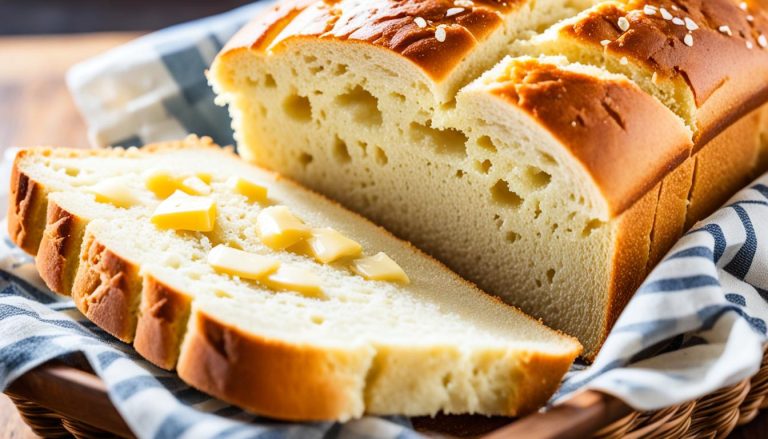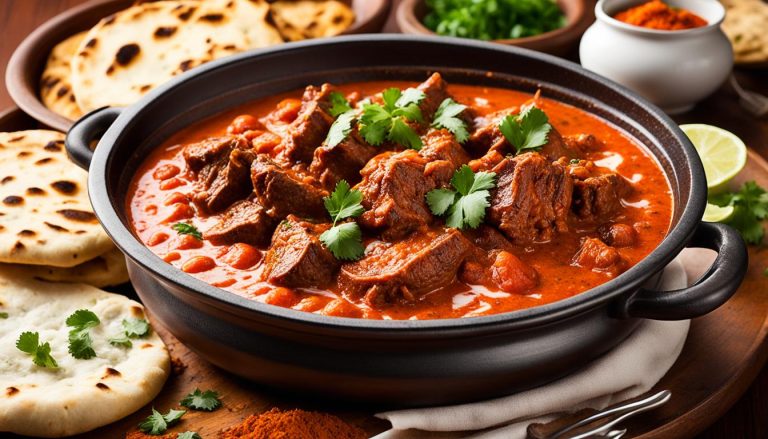Bibim Mandu is a vibrant Korean dish that brings together crispy fried or steamed dumplings with fresh, colorful vegetables coated in a sweet, spicy, and tangy gochujang dressing.
This dish offers a delightful combination of crunchy, chewy, and fresh textures in every bite. Follow this simple bibim mandu recipe to create restaurant-quality Bibim Mandu at home. Let’s dive into this delicious and refreshing dish!
Bibim Mandu Recipe Ingredients
To make Bibim Mandu, you will need the following ingredients:
For the Mandu (Dumplings)
- 10-12 frozen or fresh Korean mandu (dumplings) – pork, chicken, beef, seafood, or vegetarian
- 2 tablespoons vegetable oil (for frying or steaming)
For the Salad
- 1/2 head green or red leaf lettuce, torn into bite-sized pieces
- 1 small cucumber, julienned
- 1/2 medium carrot, julienned
- 1/4 red onion, thinly sliced
- 1/2 cup bean sprouts, blanched (optional)
- 1/4 cup perilla leaves or fresh basil, sliced (optional)
For the Gochujang Dressing
- 2 tablespoons gochujang (Korean red chili paste)
- 1 tablespoon soy sauce
- 1 tablespoon rice vinegar
- 1 tablespoon sesame oil
- 1/2 tablespoon honey (or sugar)
- 1 clove garlic, minced
- 1/2 tablespoon sesame seeds (plus more for garnish)
- 1/2 tablespoon water (optional, to adjust consistency)
Optional Toppings
- 1 hard-boiled egg, sliced in half
- 1/2 teaspoon sesame seeds (for garnish)
- 1/2 teaspoon sliced green onion or chives (for garnish)
Bibim Mandu Recipe Instructions
Step 1: Prepare the Mandu (Dumplings)

- Heat 2 tablespoons of vegetable oil in a large pan over medium heat.
- Place the frozen or fresh mandu in the pan, ensuring they do not overlap.
- Fry until the bottoms are golden brown, about 3-4 minutes.
- Add 1-2 tablespoons of water to the pan, cover with a lid, and steam for 2-3 minutes.
- Remove the lid and cook for another 1-2 minutes to make the outside crispy.
- Transfer the cooked mandu to a plate lined with a paper towel to remove excess oil.
Step 2: Prepare the Salad

- Tear the lettuce into bite-sized pieces.
- Julienne the cucumber and carrot.
- Thinly slice the red onion.
- If using perilla leaves or basil, slice them thinly.
- Blanch the bean sprouts if using, and drain well.
- In a large bowl, combine the lettuce, cucumber, carrot, red onion, perilla leaves, and blanched bean sprouts.
- Toss gently to combine.
Step 3: Make the Gochujang Dressing

- In a small bowl, whisk together the gochujang, soy sauce, rice vinegar, sesame oil, honey (or sugar), minced garlic, sesame seeds, and water.
- Adjust the water to reach your desired consistency. The dressing should be slightly thick but pourable.
- Adjust the sweetness, spiciness, and tanginess to your liking by adding more honey, vinegar, or gochujang as needed.
Step 4: Assemble the Bibim Mandu

- Pour the gochujang dressing over the prepared vegetables.
- Toss well until all the vegetables are coated with the dressing.
- Arrange the warm, crispy mandu on top of the salad.
- Add hard-boiled egg halves, sesame seeds, and sliced green onions or chives for garnish.
Step 5: Serve

Serve Bibim Mandu immediately while the mandu are still warm and crispy. This dish works perfectly as a main course, a side dish, or even a light appetizer.
Bibim Mandu Recipe Variations

- Spicy Bibim Mandu: Spice lovers will enjoy this fiery twist on Bibim Mandu. Add gochugaru (Korean chili flakes) and chili oil to the gochujang dressing, then top with red chili peppers, jalapeños, or crushed red pepper flakes for an extra punch of heat.
- Vegetarian Bibim Mandu: This plant-based option uses vegetable dumplings filled with tofu, mushrooms, or mixed vegetables. Pair with a fresh vegetable salad of cabbage and spinach, and make the dressing vegan-friendly by swapping honey for maple syrup or agave.
- Seafood Bibim Mandu: For a coastal twist, use shrimp, crab, or seafood-filled dumplings. Top the salad with fresh shrimp or seared scallops, and enhance the umami flavor by adding fish sauce and garnishing with seaweed flakes or bonito flakes.
- Grilled Bibim Mandu: Enjoy the smoky, charred flavor of grilled dumplings cooked on a BBQ grill or stovetop grill pan. Pair with grilled vegetables like zucchini, carrots, or bell peppers, and finish with a smoky gochujang BBQ-style dressing for a perfect summer meal.
- Cold Bibim Mandu (Chilled Version): This refreshing summer variation serves chilled dumplings with fresh, cold salad. Add toppings like shredded pear, chilled cucumber, and crushed ice, and pair it with a cool, tangy gochujang dressing for a light, refreshing meal.
- Fusion Bibim Mandu (Western-Inspired): Blend global cuisines with Korean flavors by using dumpling fillings like spinach-feta (Mediterranean) or black bean-corn (Mexican). Swap the gochujang dressing for tomato, chipotle, or lemon-tahini dressings for an international twist.
- Sweet & Tangy Bibim Mandu: Balance sweet and tangy flavors with dumpling fillings like sweet potato, pumpkin, or red bean. Add fresh fruits like mango, pear, or pineapple to the salad and sweeten the gochujang dressing with honey, fruit puree, or pomegranate seeds for a unique flavor profile.
Bibim Mandu Serving Suggestions

- Main Course: Turn Bibim Mandu into a hearty meal by serving 6-8 dumplings with fresh salad, steamed rice, and miso or soybean paste stew. Complete the meal with classic Korean side dishes like kimchi, pickled radish, and seasoned spinach for a full dining experience.
- Side Dish: Use Bibim Mandu as a flavorful side dish by serving 3-4 dumplings with a small salad. It pairs well with Korean BBQ meats like bulgogi, galbi, or samgyeopsal. Arrange them on a platter with colorful vegetable garnishes for an attractive presentation.
- Appetizer: Serve Bibim Mandu as a light starter with 2-3 dumplings and fresh salad. Pair them with dipping sauces like gochujang, soy sauce, or spicy mayo. Add classic appetizers like tteokbokki, kimbap, or kimchi pancakes for a flavorful appetizer spread.
- Light Lunch or Quick Meal: For a quick and nutritious lunch, serve 6-7 dumplings with a fresh salad and seaweed or clear broth soup. Pack the dumplings, salad, and dressing separately for a convenient meal-prep option that stays fresh until lunchtime.
- Party Platter or Potluck Dish: Create a stunning party platter by arranging 10-12 dumplings in a circle around a central salad bowl. Offer multiple dumpling flavors (pork, chicken, seafood, and veggie) to cater to guests’ preferences. Provide dipping sauces like soy sauce, spicy mayo, or gochujang for variety.
- Breakfast or Brunch Idea: Give your brunch a Korean twist by serving 4-5 dumplings with salad and a fried or poached egg on top. Pair it with breakfast staples like roasted potatoes, fruit salad, or smoothies for a balanced and flavorful brunch experience.
Bibim Mandu Recipe Nutrition Details
| Nutritional Information (Per Serving) | Amount |
| Calories | 400 kcal |
| Protein | 12 g |
| Carbohydrates | 50 g |
| Fat | 15 g |
| Fiber | 5 g |
| Sodium | 850 mg |
Note: Nutritional values may vary based on the type of dumplings and the quantity of vegetables used.
Conclusion
Bibim Mandu is a delicious Korean cuisine that consists of fresh vegetables, crispy dumplings, and a spicy-sweet gochujang sauce.
Whether you make it spicy, vegetarian, or seafood-inspired, this recipe offers plenty of ways to customize it. Perfect as a main course, side dish, or appetizer, Bibim Mandu is sure to impress your family and friends.
Try this simple recipe and bring the flavors of Korea to your kitchen. Enjoy!
FAQ
Can I use store-bought dumplings for Bibim Mandu?
Yes, store-bought frozen dumplings (mandu) are a great option. Look for pork, beef, chicken, seafood, or vegetable-filled varieties.
Can I prepare Bibim Mandu in advance?
Yes, you can prepare the salad ingredients and gochujang dressing ahead of time. Store them in the refrigerator and cook the mandu just before serving for the best crispy texture.
How do I store leftover Bibim Mandu?
Store leftover dumplings and salad separately. Reheat the dumplings in an air fryer or pan to regain their crispiness.The salad can be kept in the fridge for up to two days in an airtight container.
How can I make Bibim Mandu healthier?
For a lighter version, use steamed or boiled dumplings instead of fried. Reduce the amount of honey or sugar in the dressing. You can also add more fresh vegetables like spinach, kale, or shredded cabbage.
Can I use potstickers or gyoza instead of mandu?
Yes, potstickers and gyoza work well as substitutes. While they have a slightly different taste and texture, they can still be used for Bibim Mandu.
How do I make the dressing less spicy?
If you prefer a milder dressing, reduce the amount of gochujang and omit any added chili flakes. Add extra honey or sugar to balance the spiciness.

Bibim Mandu Recipe
Ingredients
- 10-12 frozen or fresh Korean mandu dumplings – pork, chicken, beef, seafood, or vegetarian
- 2 tablespoons vegetable oil for frying or steaming
- For the Salad
- 1/2 head green or red leaf lettuce torn into bite-sized pieces
- 1 small cucumber julienned
- 1/2 medium carrot julienned
- 1/4 red onion thinly sliced
- 1/2 cup bean sprouts blanched (optional)
- 1/4 cup perilla leaves or fresh basil sliced (optional)
- For the Gochujang Dressing
- 2 tablespoons gochujang Korean red chili paste
- 1 tablespoon soy sauce
- 1 tablespoon rice vinegar
- 1 tablespoon sesame oil
- 1/2 tablespoon honey or sugar
- 1 clove garlic minced
- 1/2 tablespoon sesame seeds plus more for garnish
- 1/2 tablespoon water optional, to adjust consistency
- Optional Toppings
- 1 hard-boiled egg sliced in half
- 1/2 teaspoon sesame seeds for garnish
- 1/2 teaspoon sliced green onion or chives for garnish
Instructions
- Heat 2 tablespoons of vegetable oil in a large pan over medium heat.
- Place the frozen or fresh mandu in the pan, ensuring they do not overlap.
- Fry until the bottoms are golden brown, about 3-4 minutes.
- Add 1-2 tablespoons of water to the pan, cover with a lid, and steam for 2-3 minutes.
- Remove the lid and cook for another 1-2 minutes to make the outside crispy.
- Transfer the cooked mandu to a plate lined with a paper towel to remove excess oil.
- Tear the lettuce into bite-sized pieces.
- Julienne the cucumber and carrot.
- Thinly slice the red onion.
- If using perilla leaves or basil, slice them thinly.
- Blanch the bean sprouts if using, and drain well.
- In a large bowl, combine the lettuce, cucumber, carrot, red onion, perilla leaves, and blanched bean sprouts.
- Toss gently to combine.
- In a small bowl, whisk together the gochujang, soy sauce, rice vinegar, sesame oil, honey (or sugar), minced garlic, sesame seeds, and water.
- Adjust the water to reach your desired consistency. The dressing should be slightly thick but pourable.
- Adjust the sweetness, spiciness, and tanginess to your liking by adding more honey, vinegar, or gochujang as needed.
- Pour the gochujang dressing over the prepared vegetables.
- Toss well until all the vegetables are coated with the dressing.
- Arrange the warm, crispy mandu on top of the salad.
- Add hard-boiled egg halves, sesame seeds, and sliced green onions or chives for garnish.
- Serve Bibim Mandu immediately while the mandu are still warm and crispy. This dish works perfectly as a main course, a side dish, or even a light appetizer.









